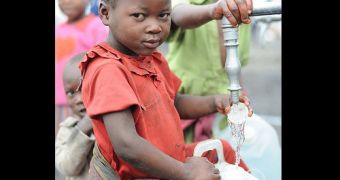Three to five million people develop cholera every year, according to the World Health Organization, and if untreated, the disease can kill within hours.
Cholera is prevalent in areas with no basic infrastructure, sanitation and clean water, and the risks for a cholera outbreak rapidly increase after a man-made or a natural disaster.
This is the case for the 1.3 million people living in Haitian refugee camps, after the earthquake in January 2010, but also for people from the flood-ravaged areas of Pakistan and the slums of Santo Domingo in Haiti's neighbor, the Dominican Republic.
Public health workers are trying to treat the tens of thousands of people already hospitalized with cholera-like symptoms, and to provide clean water and appropriate sanitation to control the spread of the disease, and a ready supply of vaccine could give them the extra help they need.
Matthew Waldor of the Howard Hughes Medical Institute, Peter Hotez of George Washington University and the Sabin Vaccine Institute, and John Clemens of the International Vaccine Institute in Korea are vaccine and infectious disease specialists, and they say that safe and effective vaccines are now available.
The only problem seems to be the quantity, as these vaccines are in short supply, and this is why the scientists encourage the US to stockpile cholera vaccines and have them ready to deploy to parts of the globe at risk for the disease.
Waldor, a microbiologist and infectious disease specialist whose laboratory at Brigham and Women's Hospital studies cholera and other pathogenic bacteria that infect the gut, says that “the resistance to vaccination is truly baffling.
“The point of view [regarding controlling cholera in Haiti] has been that effort should be made toward establishing field hospitals to provide life-saving rehydration therapy.
“I totally understand that; however, I think it's a false dichotomy to say we can only do one or the other.”
Normally, replacing the lost fluids is an effective treatment, but this can prove to be rather difficult in areas with no proper medical facilities.
As for the vaccines, there are three different oral vaccines, that are normally used to prevent the disease in regions where it is endemic: Shanchol – made by Shantha Biotechnics, Dukoral – made by Crucell and mORC-VAX from VaBiotech.
The three are relatively cheap, easy to dispense and they reduce the risk of infection by over 80% for a period of at least six months.
Full immunity is reached in adults after two doses, and in children after three doses of vaccine.
Dukoral is the only vaccine on the World Health Organization's list of prequalified medicines for use in resource-limited areas, and Shanchol is on the waiting list for WHO prequalification.
The authors say that unfortunately, “there are fewer than 400,000 total doses of oral cholera vaccines (either Dukoral or Shanchol) available at present for shipment from their manufacturers, making it impossible to consider large-scale vaccination of at-risk populations with the recommended two- or three-dose regimens of either product.”
This is the main reason for which the authors advise the US to make its own stockpile of cholera vaccine that would easily be deployed to at risk areas.
Also, the costs of having a stockpile of several million vaccine doses in the US, would be quite low, while the benefits would be huge, the authors conclude in the editorial published in the November 24, 2010, issue of the New England Journal of Medicine.

 14 DAY TRIAL //
14 DAY TRIAL //